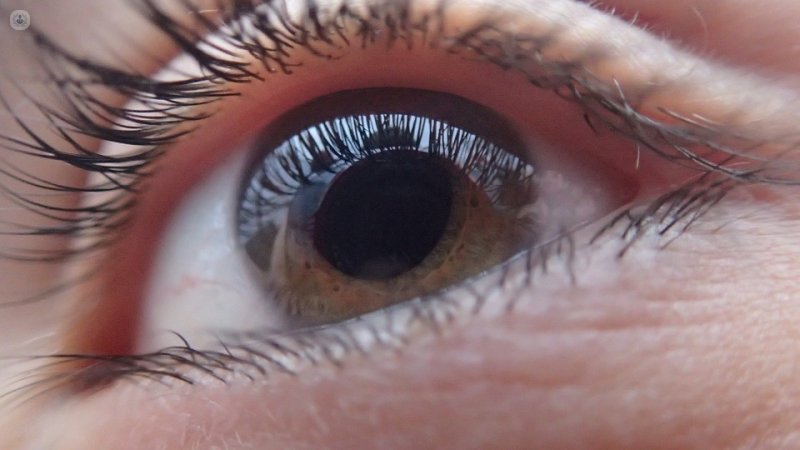Glaucoma, a silent disease
Written by:
How does glaucoma affect the eye?
Glaucoma is a disease in which nerve injuries fibers and retinal cells occur, leading to visual loss. Of the different types, chronic glaucoma is the most common, which we usually refer and which we are concerned today. Its incidence is usually preferably from 40 years of age, although sometimes it can occur earlier.
 It is a disease that we call silent, since not show any symptoms. Actually, it is a condition in which the main protagonist is the aqueous humor, a liquid that is inside the eye, which is constantly being produced in one place and eliminating the other. This balance between production and elimination, a specific and physiological ocular tone occurs, it is called eyestrain. When this balance is disrupted, typically by evacuation deficit, ie, "the drain becomes clogged" a voltage rise occurs, called ocular hypertension. As an example, we could say that if it were a balloon, it would go puffing slowly to explode, a fact which obviously can not occur in the eyes, because their walls are not distensible, but rigid and the result is damage ocular structures. This results in alterations in the visual field, which if maintained over time can lead to blindness. Lesions of the visual field affecting areas of the field that are not central, but rather between 5 and 15 degrees, as well as the periphery thereof, so that the sick to not alter the central vision, do not notice the problem because they look good until the later stages of the disease, they also end up losing this central vision.
It is a disease that we call silent, since not show any symptoms. Actually, it is a condition in which the main protagonist is the aqueous humor, a liquid that is inside the eye, which is constantly being produced in one place and eliminating the other. This balance between production and elimination, a specific and physiological ocular tone occurs, it is called eyestrain. When this balance is disrupted, typically by evacuation deficit, ie, "the drain becomes clogged" a voltage rise occurs, called ocular hypertension. As an example, we could say that if it were a balloon, it would go puffing slowly to explode, a fact which obviously can not occur in the eyes, because their walls are not distensible, but rigid and the result is damage ocular structures. This results in alterations in the visual field, which if maintained over time can lead to blindness. Lesions of the visual field affecting areas of the field that are not central, but rather between 5 and 15 degrees, as well as the periphery thereof, so that the sick to not alter the central vision, do not notice the problem because they look good until the later stages of the disease, they also end up losing this central vision.
What is your treatment?
Glaucoma can be treated medically and surgically. Medical treatment, that is with which this therapy is started, is done with topical eye drops that lower eye strain. Initially there were few troops prepared for it, however, fortunately, today we have an important therapeutic arsenal which facilitates our work. But nevertheless when we do not achieve our goal, surgical treatment is an alternative. Within the latter, filtering procedures, drainage devices, valves and even laser treatment are. In any case , the treatment should be as early as possible, since this disease produces lesions are irreversible, ie what has already been lost can not be recovered.
How can detect the condition of glaucoma in the eye?
The only way to detect glaucoma is through an ophthalmologic study. Taking eyestrain is the first thing that can guide us toward diagnosis. To this should be added the study of the fundus, with the assessment of the papilla (optic nerve) and perform a visual field, which is the test that will tell us what is the state of the eye at the time.
What advice or recommendations we can make to prevent or control it ?
Surely the same care. Regular checks of our view, action must always carry out a medical ophthalmologist. Do not forget that it is a silent disease, chronic glaucoma is painless and does not show.
Sometimes patients come to see ignorance have never made an ophthalmologic study. It is possible that all specialists a patient ever come to them because note that although "looks good", he stumbles on the street with people or at home with furniture. When you get to this situation the disease already has a significant degree of evolution and indicates that there is great damage in the visual field. The patient looks perfectly down the middle, but not on the sides, where the field has been destroyed and lacks vision. Finally, over time, this will also lose central vision.
All this is very important prevention and could be avoided only with regular eye exams at least once a year. It must be remembered something very important: glaucoma can not be cured, but it is controlled. If a glaucoma patient in treatment, abandon their medication and let the disease to their free development, with the passage of time always end in blindness.
Edited by Roser Berner Ubasos.


